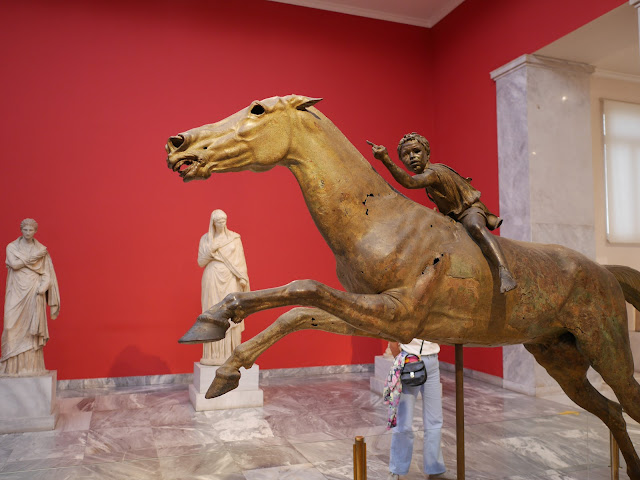The bronze "Artemision Jockey" (140 B.C.) was recovered from a shipwreck off Euboea Island in the 1920s and '30s and pieced back together in 1971. A museum sign says simply that "an American lady" helped pay for its restoration. Details at 10, I suppose.
Not a lot was known about Greek antiquity until 150 years ago. The museum's collection springs primarily from two major excavations in the late 1800s. Heinrich Schliemann excavated Mycenae and Tiryns. Christos Tsountas explored the Cyclade islands and Thessaly, uncovering the first Greek civilzations, the Neolithic and the Cycladic. Before then, Greek prehistory had no timeline, no classifications. Rounding out the museum's holdings are discoveries made in the early 20th century and items confiscated as recently as 1997 from looters, traffickers and associated lowlifes.
These exotic objects from a Mycenae grave circle about 75 miles southwest of Athens may be the oldest things I have ever seen in person. That's a genuine ostrich egg with little applied dolphins that somebody used as a drinking vessel in 16th century B.C. That's some 3,500 years ago ― before Confucious, before coins, before the number zero.
The Iron Age had not begun, but the Myceneans had a way with gold, making death masks like this.
A wall painting from the Acropolis of Mycenae from the 15th century B.C.
This striking storage jar showing an octopus in a tangle of seaweed deservedly has its own Wikipedia entry . Just reproduce it and take my money already.
The museum has a huge collection of statues, mostly of the funerary kind. Everyone looks sad because, you know, death. Even statues in a "highly fragmented state of preservation" are lovingly displayed and exhaustively described.
This grave monument is particularly heartbreaking. Known as "The Stele of Farewell" (350-325 B.C.), it shows a sitting person (dead) extending their right hand to a relative in a goodbye handclasp that is a repeated motif in the fourth century B.C. The standing woman appears to say something like "Time's up. We'll miss you." That's how I view it, anyway. Cemetery sculptures like this were considered so large and emotionally overblown that they were actually banned in 317 B.C. Boy, did I see a lot of modern-day variations in Budapest's Kerespesi Temeto cemetery.
The 3-minute walk below takes us through funerary and other statues from the 4th century B.C. through the Late Classical period (more fluid, expressive gestures), right up to the cusp of the Roman period. At 1:31 you can see the "Antikythira Youth," discovered by sponge divers in 1900. Looks like he's waving to the gallery like my son does after deliberately hitting a spectator in "Tiger Woods PGA Tour 12: The Masters." The video also gives you an idea of why the offseason of November is a great time to visit Athens. There are tourists here and there, sure, but I can't imagine what a sweaty mess this city and these halls must be like in the summertime.







Comments
Post a Comment